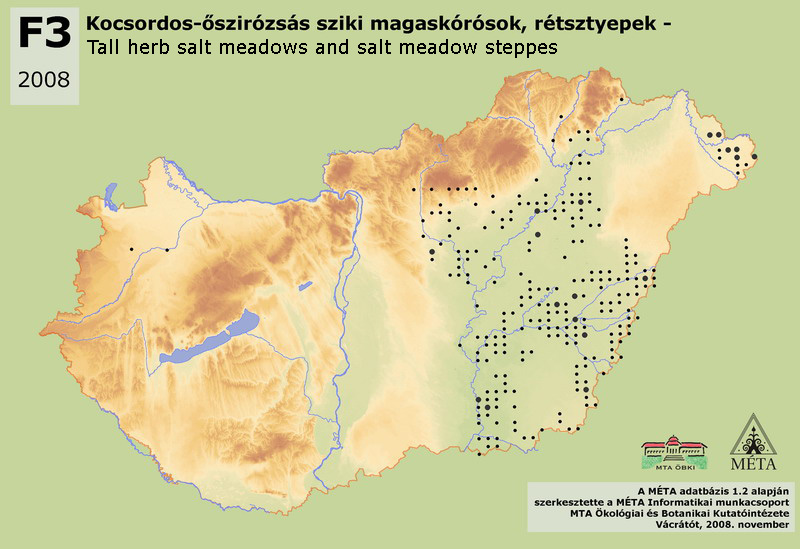MÉTA Program >>> Habitat distribution maps


F3 – Tall herb salt meadows and salt meadow steppes:
These meadows are characteristically wet in springtime and dry in summer, codominated by halophytes, fen meadow and loess steppe species, and occur mainly on Tiszántúl. Their structure is determined by tall herbs and umbellifers, with Aster punctatus, Artemisia pontica and Peucedanum officinale as the most frequent character species. The wet variants are tall grass meadows rich in character species and species of tall herb meadowsteppes, the drier ones are short grass habitats which show transition towards the Achillea steppes (F1b). Relatively rare habitat; it covers approximately 1120 ha altogether, occurring typically in the valley of Tisza River. Except some small occurrences it is missing from Dunai-Alföld (probably because of the calcareous soils), Kisalföld, Dunántúli-dombság, Nyugat-Dunántúl, and from the Dunántúli-középhegység, but it can be found on the foothills of the Északi-középhegység with 10 ha extension. 96% of the stands are on Tiszai-Alföld (1080 ha). Most of them are on salinizing floodplains or in saline environment, while other stands, like the ones on Szatmár-Beregi-sík and some in Közép-Tisza-völgy are on heavy, but not saline floodplain soils. Sometimes stands with loess steppe character can also occur (e.g. Bihari-sík, Bélmegyer, Ohat). Tall herb salt meadows and salt meadow steppes rarely occupy great patches. The most species-rich stands are connected to salt steppe oak woodlands, but most of the actual occurrences are in almost treeless landscapes.
Molnár, Zs., M. Biró, J. Bölöni & F. Horváth (2008): Distribution of the (semi-)natural habitats in Hungary I.: Marshes and grasslands, Acta Botanica Hungarica 50 (Suppl): 59-105. >>> letöltés (5,4 MB, PDF)
MÉTA Program,
MÉTA Fotótár
MÉTA Élőhely-Ismereti Útmutató (ÉIÚ),
MÉTA Adatlap-Kitöltési Útmutató (AL-KÚ)
(C) MÉTA Informatika, 2005-2009,
MTA Ökológiai és Botanikai Kutatóintézete
F3 - Tall herb salt meadows and salt meadow steppes - Kocsordos-őszirózsás sziki magaskórósok, rétsztyepek (HU)
Attachment
KV_EH_f3_elterjedes_2.0.jpg 167.39 KB